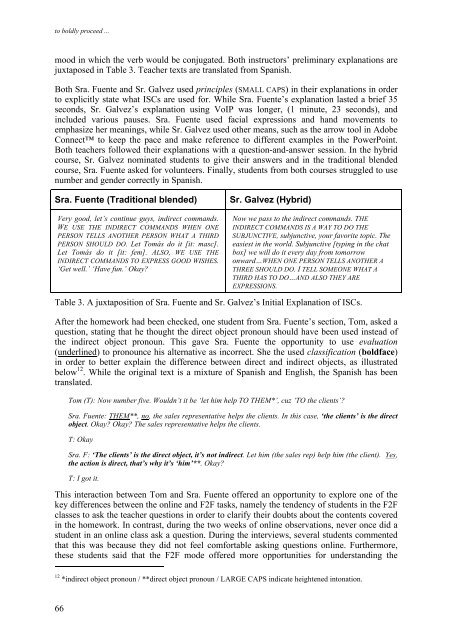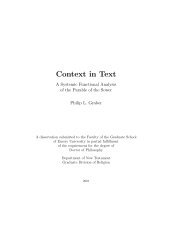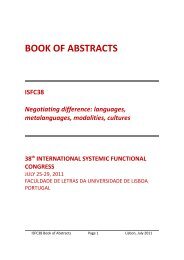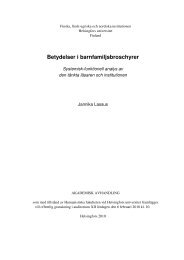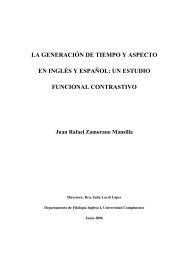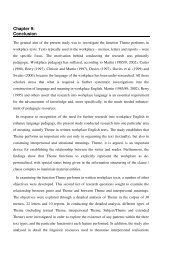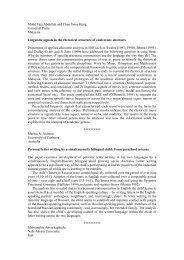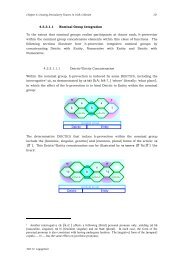the ISFC39 Proceedings - International Systemic-Functional ...
the ISFC39 Proceedings - International Systemic-Functional ...
the ISFC39 Proceedings - International Systemic-Functional ...
Create successful ePaper yourself
Turn your PDF publications into a flip-book with our unique Google optimized e-Paper software.
to boldly proceed ...mood in which <strong>the</strong> verb would be conjugated. Both instructors’ preliminary explanations arejuxtaposed in Table 3. Teacher texts are translated from Spanish.Both Sra. Fuente and Sr. Galvez used principles (SMALL CAPS) in <strong>the</strong>ir explanations in orderto explicitly state what ISCs are used for. While Sra. Fuente’s explanation lasted a brief 35seconds, Sr. Galvez’s explanation using VoIP was longer, (1 minute, 23 seconds), andincluded various pauses. Sra. Fuente used facial expressions and hand movements toemphasize her meanings, while Sr. Galvez used o<strong>the</strong>r means, such as <strong>the</strong> arrow tool in AdobeConnect to keep <strong>the</strong> pace and make reference to different examples in <strong>the</strong> PowerPoint.Both teachers followed <strong>the</strong>ir explanations with a question-and-answer session. In <strong>the</strong> hybridcourse, Sr. Galvez nominated students to give <strong>the</strong>ir answers and in <strong>the</strong> traditional blendedcourse, Sra. Fuente asked for volunteers. Finally, students from both courses struggled to usenumber and gender correctly in Spanish.Sra. Fuente (Traditional blended)Very good, let’s continue guys, indirect commands.WE USE THE INDIRECT COMMANDS WHEN ONEPERSON TELLS ANOTHER PERSON WHAT A THIRDPERSON SHOULD DO. Let Tomás do it [it: masc].Let Tomás do it [it: fem]. ALSO, WE USE THEINDIRECT COMMANDS TO EXPRESS GOOD WISHES.‘Get well.’ ‘Have fun.’ Okay?Sr. Galvez (Hybrid)Now we pass to <strong>the</strong> indirect commands. THEINDIRECT COMMANDS IS A WAY TO DO THESUBJUNCTIVE, subjunctive, your favorite topic. Theeasiest in <strong>the</strong> world. Subjunctive [typing in <strong>the</strong> chatbox] we will do it every day from tomorrowonward…WHEN ONE PERSON TELLS ANOTHER ATHREE SHOULD DO. I TELL SOMEONE WHAT ATHIRD HAS TO DO…AND ALSO THEY AREEXPRESSIONS.Table 3. A juxtaposition of Sra. Fuente and Sr. Galvez’s Initial Explanation of ISCs.After <strong>the</strong> homework had been checked, one student from Sra. Fuente’s section, Tom, asked aquestion, stating that he thought <strong>the</strong> direct object pronoun should have been used instead of<strong>the</strong> indirect object pronoun. This gave Sra. Fuente <strong>the</strong> opportunity to use evaluation(underlined) to pronounce his alternative as incorrect. She <strong>the</strong> used classification (boldface)in order to better explain <strong>the</strong> difference between direct and indirect objects, as illustratedbelow 12 . While <strong>the</strong> original text is a mixture of Spanish and English, <strong>the</strong> Spanish has beentranslated.Tom (T): Now number five. Wouldn’t it be ‘let him help TO THEM*’, cuz ‘TO <strong>the</strong> clients’?Sra. Fuente: THEM**, no, <strong>the</strong> sales representative helps <strong>the</strong> clients. In this case, ‘<strong>the</strong> clients’ is <strong>the</strong> directobject. Okay? Okay? The sales representative helps <strong>the</strong> clients.T: OkaySra. F: ‘The clients’ is <strong>the</strong> direct object, it’s not indirect. Let him (<strong>the</strong> sales rep) help him (<strong>the</strong> client). Yes,<strong>the</strong> action is direct, that’s why it’s ‘him’**. Okay?T: I got it.This interaction between Tom and Sra. Fuente offered an opportunity to explore one of <strong>the</strong>key differences between <strong>the</strong> online and F2F tasks, namely <strong>the</strong> tendency of students in <strong>the</strong> F2Fclasses to ask <strong>the</strong> teacher questions in order to clarify <strong>the</strong>ir doubts about <strong>the</strong> contents coveredin <strong>the</strong> homework. In contrast, during <strong>the</strong> two weeks of online observations, never once did astudent in an online class ask a question. During <strong>the</strong> interviews, several students commentedthat this was because <strong>the</strong>y did not feel comfortable asking questions online. Fur<strong>the</strong>rmore,<strong>the</strong>se students said that <strong>the</strong> F2F mode offered more opportunities for understanding <strong>the</strong>12 *indirect object pronoun / **direct object pronoun / LARGE CAPS indicate heightened intonation.66


